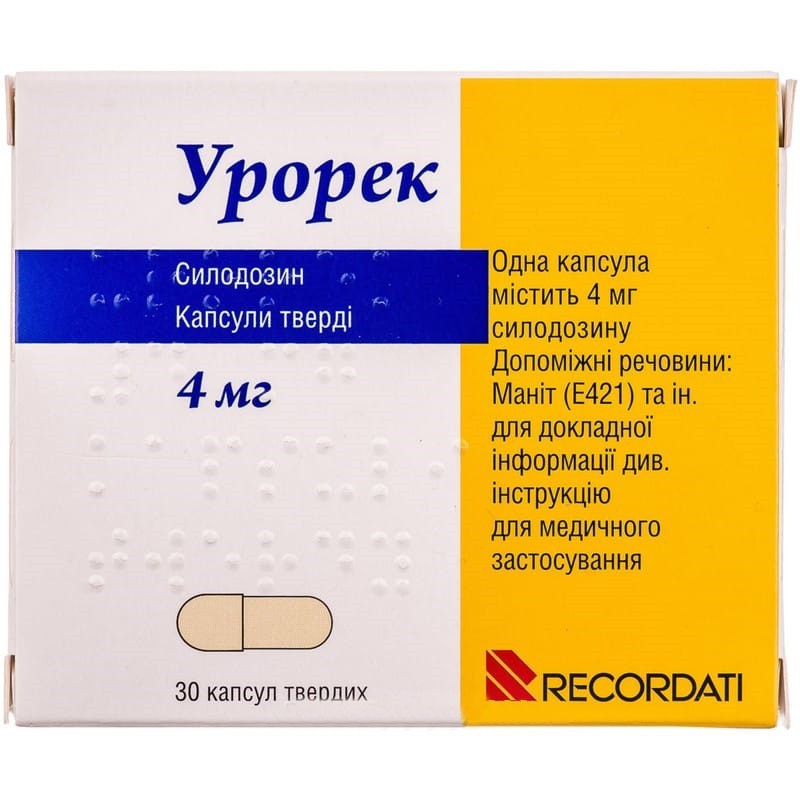



 Secure and encrypted payment processing
Secure and encrypted payment processing We ship to over 40 countries including the USA, UK, Europe, Australia and Japan
We ship to over 40 countries including the USA, UK, Europe, Australia and Japan Guaranteed refund or reship if you haven't received your order
Guaranteed refund or reship if you haven't received your orderPharmacodynamic parameters. silodosin is highly selective for α1a receptors located in the prostate gland, bladder triangle and lower urinary tract. blocking these receptors relaxes smooth muscles, which reduces resistance at the exit from the bladder without affecting contractility of detrusor smooth muscles, leads to an improvement in urine outflow and a decrease in the severity of symptoms of benign prostatic hyperplasia, such as difficulty urinating, frequent urination and the inability to completely empty the urine the bubble. the selectivity of binding of silodosin to α1a receptors is 162 times higher in comparison with α1b receptors associated with the cardiovascular system, which maximizes the activity of the target organ while minimizing the potential for hell. there is no effect of silodosin (8 and 24 mg / day) on the processes of repolarization in the myocardium or ECG intervals.
Pharmacokinetic parameters. Silodosin and its glucuronide reach equilibrium after 3 and 5 days of therapy, respectively.
The drug is rapidly absorbed in the intestine, and its pharmacokinetic parameters - Cmax and AUC increase linearly with dose. The bioavailability of silodosin in a therapeutic dose is almost 32% with a distribution volume of 49.5 l, the drug binds to plasma proteins by 96.6%. Time to reach Cmax silodosin occurs approximately 2.6 hours after taking the drug. Silodosin is a substrate for P-glycoprotein.
Food is involved in the pharmacokinetic pathway of the drug. AUC and Cmax decrease by 4–49% and 18–43%, respectively, with moderate caloric content / fat content of food. In addition, eating delays the time to reach Cmax for about an hour.
Silodosin is rapidly metabolized in the liver. The main metabolite (KMD-3213G) is formed by glucuronidation. The metabolization of silodosin also occurs with the participation of alcohol dehydrogenase and aldehyde dehydrogenase and oxidation reactions. The second major metabolite, KMD-3293, is inactive.
Silodosin does not have effects of inhibition or potentiation of the cytochrome P450 system.
KMD-3213G due to its high hydrophilicity accumulates in blood plasma and has 50% inhibitory activity of silodosin. This glucuronide conjugate has T½ about 24 hours compared with 13.3 hours for silodosin and AUC 3-4 times higher than the parent compound. Thus, silodosin and its active metabolite have a long T½, which makes possible dosing 1 time per day. Silodosin is mainly excreted in the form of metabolites with urine (33.5%) and feces (54.9%). The clearance of silodosin is about 0.28 l / h / kg.
A single dose of silodosin (unbound) in patients with mild to moderate renal failure leads to an average 1.6-fold increase in Cmax and 1.7 times the AUC relative to individuals with normal renal function. In subjects with severe renal failure, exposure increases 2.2-fold for Cmax and 3.7 times for AUC. Exposure to major metabolites is also increasing. After 4 weeks of treatment, total silodosin doubles on average in patients with moderate impaired renal function. Preclinical studies have not revealed carcinogenic, mutagenic and teratogenic potential of silodosin.
Benign prostatic hyperplasia (symptomatic therapy).
Adults per os during meals 1 time per day (it is preferable to adhere to the reception at the same time) 8 mg. for certain groups of patients, the dose is 4 mg (1 time per day). do not chew the capsule, drink a glass of water.
There is no need for dose adjustment in elderly patients or in patients with moderate or moderate severity of liver failure, as well as moderate renal failure (creatinine clearance of 50–80 ml / min).If creatinine clearance is 30–49 ml / min, the starting dose is 4 mg / day; after 1 week, a dose increase to 8 mg / day is possible.
Hypersensitivity to the active substance of the drug or any of its components.
Before a planned operation for cataract, Urorec is not used. treatment with antagonists of α1-adrenergic receptors is canceled 1-2 weeks before such an intervention due to the likelihood of developing atonic iris syndrome.
The drug should not be used in patients with postural hypotension, as well as with severe or severe hepatic or renal failure.
Prior to the use of Urorec, it is necessary to ensure that the patient is excluded from the diagnosis of prostate cancer.
Normal ejaculation is restored after completion of drug therapy.
Not used in childhood and in female patients.
Due to the likelihood of developing symptoms of postural hypotension, the patient should not drive vehicles or work with other mechanisms until the response of his body to the drug is clarified.
In case of symptoms of postural hypotension, the patient should take a horizontal or semi-vertical position until the moment when these manifestations disappear.
It should not be combined with other blockers of α-adrenergic receptors, as well as with strong cyp 3a4 inhibitors (among others ritonavir, itraconazole, ketoconazole).
Moderate CYP 3A4 inhibitors (including diltiazem), as well as a substrate of P-glycoprotein digoxin, when combined with silodosin, do not require dose adjustment of the latter.
In order to prevent the development of undesirable reactions, caution and monitoring of the condition of patients with the combined use of sildosine with antihypertensive agents or PDE-5 inhibitors are necessary.
In the case of recent administration of the drug, induce artificial vomiting or provide gastric lavage. if excessive intake of the drug is accompanied by a decrease in hell (90/60 mmHg), support for cardiovascular functions is required. hemodialysis is ineffective due to the high connection of the substance with blood plasma proteins.
In a place inaccessible to children, at a temperature of ≤30 ° C in the original packaging.